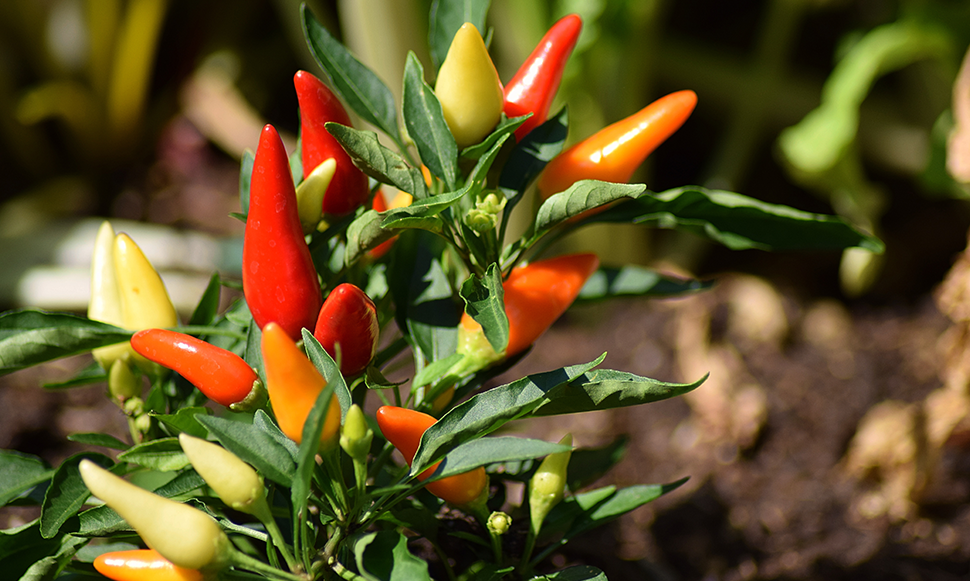Estudio del efecto de la sequía inducida por polietilenglicol en Capsicum frutescens en un sistema hidropónico
DOI:
https://doi.org/10.31644/IMASD.34.2023.a03Palabras clave:
Sequía, Capsicum frutescens, Tolerancia, SupervivenciaResumen
La sequía es el factor más común que limita el desarrollo y productividad de los cultivos, afectando severamente a la agricultura. En México, uno de los cultivos de importancia económica y gastronómica sensible al estrés hídrico es el género Capsicum. En el presente estudio se evaluó la aplicación de prolina en plantas de Capsicum frutescens expuestas a sequía inducida por polietilenglicol (PEG) en un sistema hidropónico. Empleando un diseño factorial 22, se evaluaron un total de 60 plántulas durante 120 h dividas en cuatro tratamientos: PEG (0 y 10 %) y Pro (0 y 10 mM) como variables de estudio. Los resultados demostraron que la exposición a 10 mM de Pro indujo un aumento significativo en la concentración de clorofila y de prolina endógena (hoja y raíz) en las plántulas en ausencia de estrés. Además, se observó un 80 % de supervivencia de las plántulas y un aumento en el contenido de prolina en aquellas que estuvieron expuestas a 10 mM Pro + 10 % PEG. De igual manera, se presentó un aumento en el contenido de clorofila (13 µg • mL-1), contenido relativo de agua (CRA) en raíz (77.6 %), porcentaje de electrolitos en hoja y raíz (~44 y ~52 % respectivamente), en comparación con el tratamiento de 0 mM Pro + 10 % PEG. Los resultados sugieren que la aplicación previa de prolina tiene un efecto positivo en la supervivencia de las plántulas bajo condiciones de sequía inducida por PEG.
Descargas
Citas
Abobatta, W. F. (2020). Plant Responses and Tolerance to Combined Salt and Drought Stress. 17–52. https://doi.org/10.1007/978-3-030-40277-8_2
Alkahtani, M. D. F., Hafez, Y. M., Attia, K., Rashwan, E., Husnain, L. Al, Algwaiz, H. I. M., & Abdelaal, K. A. A. (2021). Evaluation of Silicon and Proline Application on the Oxidative Machinery in Drought-Stressed Sugar Beet. Antioxidants 2021, Vol. 10, Page 398, 10(3), 398. https://doi.org/10.3390/ANTIOX10030398
Alvarez, M. E., Savouré, A., & Szabados, L. (2022). Proline metabolism as regulatory hub. Trends in Plant Science, 27(1), 39–55. https://doi.org/10.1016/J.TPLANTS.2021.07.009
Ashraf, M. A., Iqbal, M., Rasheed, R., Hussain, I., Perveen, S., & Mahmood, S. (2018). Dynamic Proline Metabolism: Importance and Regulation in Water-Limited Environments. Plant Metabolites and Regulation under Environmental Stress, 323–336. https://doi.org/10.1016/B978-0-12-812689-9.00016-9
Cha-um, S., Rai, V., & Takabe, T. (2019). Proline, Glycinebetaine, and Trehalose Uptake and Inter-Organ Transport in Plants Under Stress. Osmoprotectant-Mediated Abiotic Stress Tolerance in Plants, 201–223. https://doi.org/10.1007/978-3-030-27423-8_9
de Freitas, P. A. F., de Carvalho, H. H., Costa, J. H., Miranda, R. de S., Saraiva, K. D. da C., de Oliveira, F. D. B., Coelho, D. G., Prisco, J. T., & Gomes-Filho, E. (2019). Salt acclimation in sorghum plants by exogenous proline: physiological and biochemical changes and regulation of proline metabolism. Plant Cell Reports, 38(3), 403–416. https://doi.org/10.1007/s00299-019-02382-5
dos Santos, T. B., Ribas, A. F., de Souza, S. G. H., Budzinski, I. G. F., & Domingues, D. S. (2022). Physiological Responses to Drought, Salinity, and Heat Stress in Plants: A Review. Stresses, 2(1), 113–135. https://doi.org/10.3390/stresses2010009
Elewa, T. A., Sadak, M. S., & Saad, A. M. (2017). Proline treatment improves physiological responses in quinoa plants under drought stress. Bioscience Research, 14(1), 21–33.
Escalante-Magaña, C. A. (2020). Efecto del estrés salino (NaCl) sobre el metabolismo de la prolina (Pro) y el papel de este aa suplementado de manera exógena en plantas de chile habanero (Capsicum chinense Jacq.) [Tesis que presenta Camilo Andrés Escalante Magaña, en opción al título de Doctorado en Ciencias (Ciencias Biológicas: Opción Bioquímica y Biología Molecular)] Centro de Investigación Científica de Yucatán, A. C.
Food and Agriculture Organization, FAOSTAT. (Retrieved April 24, 2023). https://www.fao.org/faostat/en/#data/QCL/visualize
Farooq, M., Nawaz, A., Chaudhry, M. A. M., Indrasti, R., & Rehman, A. (2017). Improving resistance against terminal drought in bread wheat by exogenous application of proline and gamma-aminobutyric acid. Journal of Agronomy and Crop Science, 203(6), 464–472. https://doi.org/10.1111/JAC.12222
Hoagland, D. R., & Arnon, D. I. (1950). Preparing the nutrient solution. The Water-Culture Method for Growing Plants without Soil, 347, 29–31.
Hosseinifard, M., Stefaniak, S., Javid, M. G., Soltani, E., Wojtyla, Ł., & Garnczarska, M. (2022). Contribution of Exogenous Proline to Abiotic Stresses Tolerance in Plants: A Review. International Journal of Molecular Sciences 2022, Vol. 23, Page 5186, 23(9), 5186. https://doi.org/10.3390/IJMS23095186
Inskeep, W. P., & Bloom, P. R. (1985). Extinction Coefficients of Chlorophyll a and b in N, N-Dimethylformamide and 80% Acetone . Plant Physiology, 77(2), 483–485. https://doi.org/10.1104/pp.77.2.483
Jalil, S. U., & Ansari, M. I. (2020). Stress implications and crop productivity. Plant Ecophysiology and Adaptation under Climate Change: Mechanisms and Perspectives I: General Consequences and Plant Responses, 73–86. https://link.springer.com/chapter/10.1007/978-981-15-2156-0_3
Jothimani, K., & Arulbalachandran, D. (2020). Physiological and biochemical studies of black gram (Vigna mungo (L.) Hepper) under polyethylene glycol induced drought stress. Biocatalysis and Agricultural Biotechnology, 29(June), 101777. https://doi.org/10.1016/j.bcab.2020.101777
la Cruz-Lázaro, D., Efraín de la Cruz-Lázaro, M., Márquez-Quiroz, C., Osorio-Osorio, R., Preciado-Rangel, P., y Márquez-Hernández, C. (2017). Caracterización morfológica in situ de chile silvestre pico de paloma (Capsicum frutescens) en Tabasco, México. Acta Universitaria, 27(2), 10–16. https://doi.org/10.15174/au.2017.1083
Merwad, A. R. M. A., Desoky, E. S. M., & Rady, M. M. (2018). Response of water deficit-stressed Vigna unguiculata performances to silicon, proline or methionine foliar application. Scientia Horticulturae, 228, 132–144. https://doi.org/10.1016/J.SCIENTA.2017.10.008
Pandey, A. K., Ghosh, A., Rai, K., Fatima, A., Agrawal, M., & Agrawal, S. B. (2019). Abiotic Stress in Plants. Approaches for Enhancing Abiotic Stress Tolerance in Plants, 1–46. https://doi.org/10.1201/9781351104722
Peñalba, D. (2022). Recursos Naturales y Ambiente 41(22), 78–84. https://orcid.org/0000-0002-0407-3712/
Restrepo, H., Gómez, M. I., Garzón, A., Alzate, F. y López, J. (2013). Respuesta bioquímica de plántulas de maíz (Zea mays L.) a diferentes condiciones de temperaturas nocturnas. Revista Colombiana de Ciencias Hortícolas, 7(2), 252–262.
Sahoo, S., Borgohain, P., Saha, B., Moulick, D., Tanti, B., & Panda, S. K. (2019). Seed Priming and Seedling Pre-treatment Induced Tolerance to Drought and Salt Stress: Recent Advances. Priming and Pretreatment of Seeds and Seedlings, 253–263. https://doi.org/10.1007/978-981-13-8625-1_12
Semida, W. M., Abdelkhalik, A., Rady, M. O. A., Marey, R. A., & Abd El-Mageed, T. A. (2020). Exogenously applied proline enhances growth and productivity of drought stressed onion by improving photosynthetic efficiency, water use efficiency and up-regulating osmoprotectants. Scientia Horticulturae, 272, 109580. https://doi.org/10.1016/j.scienta.2020.109580
Suekawa, M., Fujikawa, Y., & Esaka, M. (2019). Exogenous proline has favorable effects on growth and browning suppression in rice but not in tobacco. Plant Physiology and Biochemistry, 142, 1–7. https://doi.org/10.1016/J.PLAPHY.2019.06.032
Taiwo, A. F., Daramola, O., Sow, M., & Semwal, V. K. (2020). Ecophysiology and responses of plants under drought. Plant Ecophysiology and Adaptation under Climate Change: Mechanisms and Perspectives I: General Consequences and Plant Responses, 231–268. https://doi.org/10.1007/978-981-15-2156-0_8
Toppino, L., Prohens, J., Rotino, G. L., Plazas, M., Parisi, M., Carrizo García, C., & Tripodi, P. (2021). Pepper and Eggplant Genetic Resources. 119–154. https://doi.org/10.1007/978-3-030-30343-3_6
Tripodi, P., & Kumar, S. (2019). The Capsicum Crop: An Introduction. 1–8. https://doi.org/10.1007/978-3-319-97217-6_1

Publicado
Versiones
- 01-02-2024 (2)
- 01-10-2023 (1)
Cómo citar
Número
Sección
Licencia

Esta obra está bajo una licencia internacional Creative Commons Atribución-NoComercial-CompartirIgual 4.0.























